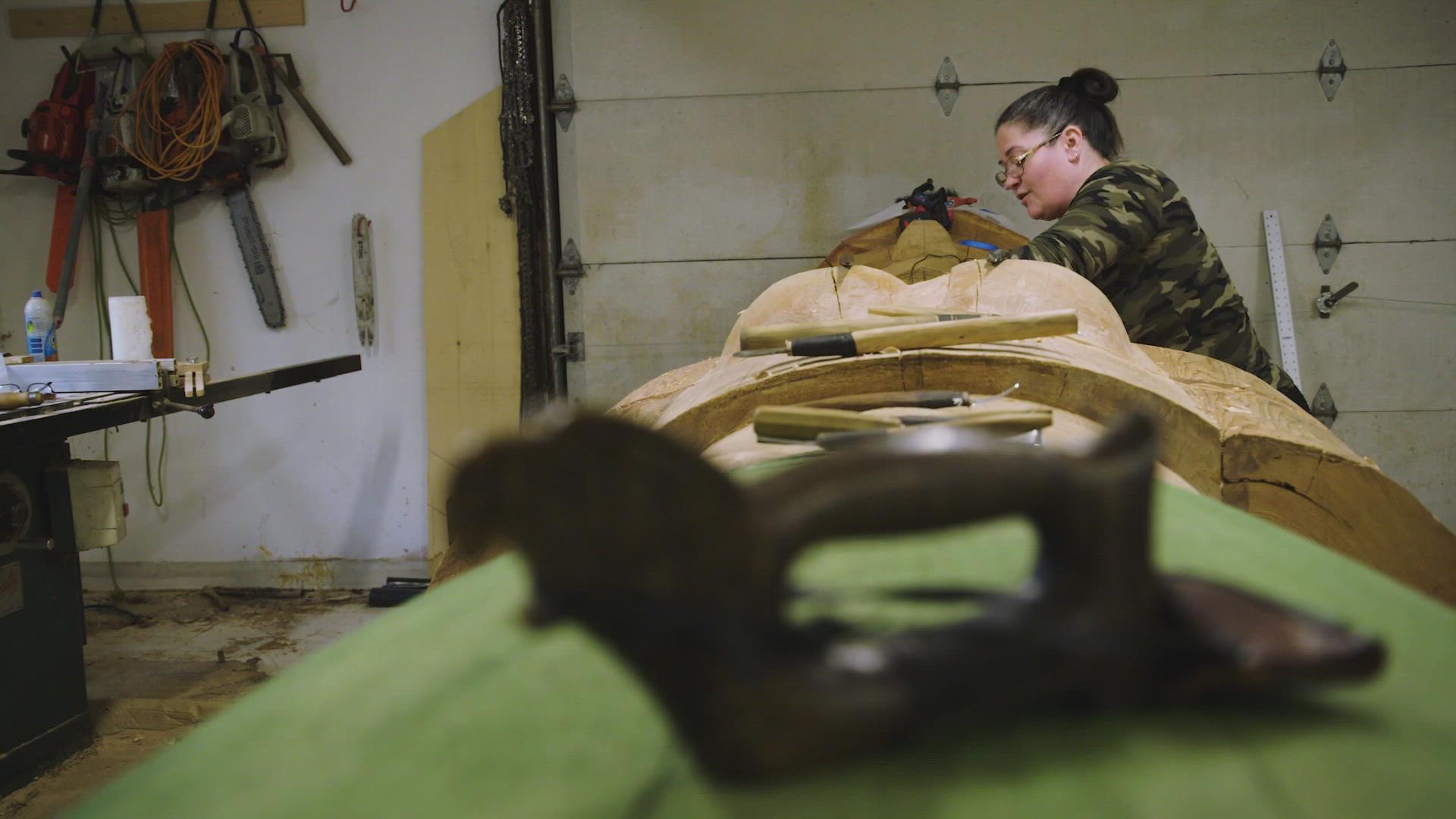SHELTON, Wash. — It's a billion-dollar industry built on ripping off Native American art and design. The sale of knockoff Native artwork is a federal crime but that's not stopping people from making a profit.
It’s a law many say isn’t helping Indigenous artists either.
In her Shelton studio, art is a language that speaks to Andrea Wilbur-Sigo, a carver with the Squaxin Tribe. Each nudge, each nick is a dialect.
“This is our written language. It's always been told we didn't have a written language. But this is it,” said Wilbur-Sigo. “All of our history is in every one of those art pieces.”
From fashion runways to fleece blankets, for decades corporate America has plastered Native American art and design all over their products. But consumers may not know that very little of that mass-produced work is done by real Native artists.
“I've been beaten out by quite a few non-Native artists for good jobs,” said Wilbur Sigo. “I would have to say they get better prices than we do.”
In 1990, Congress created the Indian Arts and Crafts Act (IACA). Under federal law, if you’re selling or representing your work as native, and it’s not – you’re committing a federal crime. Instead, you have to be honest: by saying the work is “native-inspired” or “native style.”
Law with no teeth
“This is a law that does not have the teeth that it should have to protect the legitimate Indian arts and crafts industry,” said Gabe Galanda, a Seattle-based Indigenous rights lawyer.
Galanda said that as of 2022 the act is outdated and doesn’t include any enforcement measures.
“[Enforcement] appears that's what's missing. There has to be some process by which the question is being asked: ‘Are you indigenous? Is your art indigenous?’ And if you say you are and you say it is, can you please show us the proof,” said Galanda.
The penalties for misrepresenting “Native” art are steep – a $250,000 fine and up to five years in prison – but are not enough to stop everyone.
Washington men charged
In December, two western Washington men were charged with violating the IACA. Lewis Anthony Rath (aka Tona Rath), 52, and Chris Van Dyke (aka Jerry Witten), 67, are accused of creating and selling work they marketed as Native. Some of the pieces were sold in Seattle’s Pike Place Market.
“These acts operate to displace indigenous artists, from their craft, from their livelihood, and from the economy that they deserve to have a place in,” said Galanda.
A multi-million dollar, international business
Ripping off Native American artwork is a multi-million dollar business.
In 2016, law enforcement seizures in New Mexico and California uncovered $35 million in counterfeit art. The U.S. Department of Justice recently charged eight people with smuggling in jewelry that appeared to be Native American, but the items were actually knockoffs smuggled in from the Philippines.
“I think people think it's an easy way just to make some money,” said Colleen Echohawk, CEO of Eighth Generation store. “This whole store is about Native people who are inspired and are creating this beautiful art.”
Echohawk said she didn’t know it, but even here at a shop dedicated to Native American art, they sold a counterfeit item from Rath.
“I was made aware of that. And it was because of that instance that we started collecting tribal identification and ask people to show us, you know, their enrollment cards in their tribe so that we can ensure that the art that we are putting out there is going to go back to the Native community and see prosperity for Native people, Native artists,” Echohawk said.
Harmful to Native artists
Back in Wilbur-Sigo’s Shelton studio, she said there’s another problem with the law. If she or any other Native artist allows a non-Native person to help with the creation of a piece of art, under current law, that work has to be labeled "Native style" or "Native inspired."
“Now you're telling me I have to market my work the same as any other non-Native person?” Wilbur-Sigo said.
Wilbur-Sigo pledged that she "will change this federal law in my lifetime.”
She added that she could really use help from her mother, also a carver, but because her mother is not Native, that’s not possible.
“We should be able to say it's Native, it's ours. It's cultural, it's spiritual. It comes from the roots we were all born from. And nobody can clip those roots,” said Wilbur-Sigo. “The only thing this law does is harm Native people from succeeding, becoming successful, doing exactly what we've always done. Dream bigger."
In a few weeks, Wilbur-Sigo’s biggest dream, her latest work, a 21-foot carving of Grandmother Frog, will find a permanent place in downtown Seattle.
“It's our written history and our future and our present,” said Wilbur-Sigo. “Without it, we lose a big part of our soul on where we've come from and where we're going.”
How to spot knockoffs
If you’re in the market for Native artwork, you should ask for proof that the piece was made by a Native artist and is authentic. That could include a bio of the artist and information about their tribal affiliation. Watch out for words like "Native inspired" or "Native style." Those pieces could be made by anyone.

